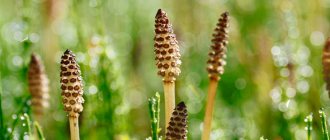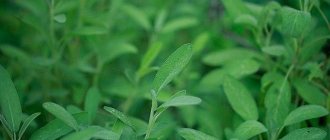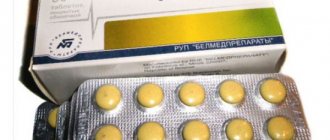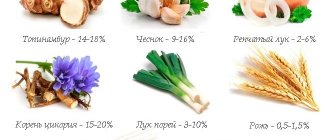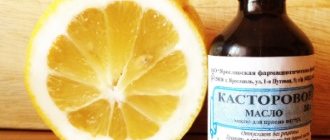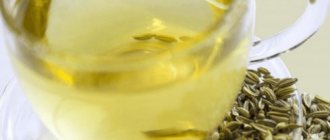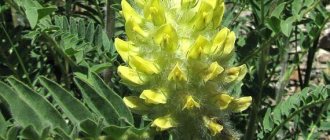Instructions for use:
- 1. Useful properties
- 2. Application
Bogorodskaya grass is a plant whose benefits determine its active use as a medicine.
Bogorodskaya herb is called thyme in Russia, thyme in Ukraine, and there is another name for this plant - materina. Bogorodskaya grass belongs to the Lamiaceae family. This is a low perennial shrub with a woody taproot and stems spread out on the ground, covered with hairs. The leaves of the plant are very hard, ovoid or linear-oblong in shape. It blooms with pink-purple flowers from June to August.
Bogorodskaya grass grows in rocky steppe areas, near low mountains, and in dry pine forests. The shrub grows in Central Russia, the south of Ukraine, the Caucasus, Siberia, Kazakhstan and, in places, the Urals.
The first mention of Bogorodskaya herb and its use is found in the chronicles of the third millennium BC. The ancient Egyptians found the use of Bogorodskaya herb as a component in the composition of the embalming agent for the pharaohs, and representatives of the ancient Sumerian civilization used the beneficial properties of Bogorodskaya herb as an antiseptic.
Many peoples, including our ancestors, the Slavs, pleased the gods by burning grass on a fire and fumigating them with fragrant smoke. This is where the common name for the plant came from, not like Bogorodskaya herb, but thyme, translated from Latin, means sacrifice.
Chemical composition of thyme
The healing properties of thyme are due to its rich composition. The plant contains:
- 0.1-1.7% essential oil, the main components of which are thymol and carvacrol;
- tannins, bitters, gum;
- ursolic, caffeic, chlorogenic and oleanolic acids;
- flavonoids;
- terpenes;
- vitamins: , , group B;
- macro- and microelements: potassium, calcium, magnesium, phosphorus, iron, manganese, copper, copper, zinc.
Indications for use
The use of Bogorodskaya herb is due to its wide range of medicinal properties, so the plant is used for effective therapy for:
- Bronchitis;
- Tracheitis;
- Pneumonia;
- Bronchial asthma;
- Tuberculosis;
- Stomatitis;
- Tonsillitis;
- Pharyngitis;
- Gingivitis;
- Anemia;
- Intestinal atony;
- Hypotension;
- Mycosis;
- Asthenia;
- Helminthiasis;
- Whooping cough;
- Dermatosis;
- Furunculosis;
- Impotence;
- Prostatitis;
- Diarrhea.
Medicinal properties of thyme
The use of thyme is advisable for the following diseases and pathological conditions:
- ENT diseases: colds, pharyngitis, tonsillitis, laryngitis;
- Pulmonology: bronchitis and bronchial asthma;
- Neurology: stress, insomnia, neurosis, neuralgia;
- Gastroenterology: gastritis, gastrointestinal colic, flatulence, diarrhea, constipation;
- Diseases of the musculoskeletal system: radiculitis, osteochondrosis, rheumatism, sprain;
- Skin diseases: purulent wounds, ulcers, boils, acne;
- Other: sciatica, gum disease, dandruff, prostatitis, impotence, alcohol addiction.
Thyme also has the following beneficial properties:
- antiseptic;
- wound healing;
- anti-inflammatory;
- expectorant, thinning sputum;
- carminative;
- anthelmintic.
Form of release of pharmaceutical products
Medication options with thyme:
- Essential oil. Sold in bottles of 10–30 ml. Resembles a viscous transparent liquid of yellow color.
- Thyme tincture. Contains ethanol. Recommended for rubbing and use as a diaphoretic, antipyretic, and antiseptic.
- Liquid extract. Sold in containers of 30–50 ml. Used for oral administration for upper respiratory tract infections and inflammation of the oral cavity.
- Syrup "Pertussin". Brown liquid of thick consistency with an expectorant, bronchospasmolytic, antimicrobial effect. Recommended for diseases accompanied by sputum secretion from the lungs. Prescribed for whooping cough.
- “Thyme” syrup with vitamin C. Used for indigestion, respiratory tract infections, and inflammation in the oral cavity.
- Bronchicum lozenges and syrup. Expectorant drugs used during the treatment of ARVI.
- Drops "Bronchosept". Indications for use: treatment of diseases accompanied by difficult to separate sputum. For example, bronchitis, tracheitis.
- Bronchipret tablets. In addition to thyme extract, they contain primrose. Prescribed for respiratory diseases.
- Tussamag drops. Allowed for children over 1 year old. Help remove mucus from the lungs and bronchi.
- Syrup "Gerbion". Expectorant.
- Capsules "Moroccan Thyme". Used as a mucolytic, diuretic, tonic, analgesic, sedative. Refers to dietary supplements.
- Cream "Vivasan". Multifunctional product for application to the skin in problem areas. Used for colds, gastrointestinal disorders, and pathologies of the musculoskeletal system.
In stores you can buy thyme raw materials in bags for quick preparation of drinks. For example, black tea with thyme from, raw materials with fireweed tea from “Maisky”, Spring Melody from Greenfield, “Royal thyme and rosemary” from Richard. The herb is also sold as a seasoning. Thus, a separate spice and a mixture of “Provencal herbs” are sold.
Essential oil: properties and applications
Thyme essential oil has a high concentration of thymol and carvacrol, which are natural antibiotics. The product is able to quickly penetrate the body through the skin and through inhalation.
The usefulness of thyme oil lies in the following properties:
- antibacterial;
- antiviral;
- immunostimulating;
- calming;
- diuretics;
- carminatives;
- tonic;
- anthelmintic;
- wound healing;
- antispasmodic;
- expectorants.
The oil is used in aromatherapy, preparing invigorating drinks, cosmetics, and perfumes. Examples of treatment applications:
- inhalations to relieve cough;
- rubbing joints to eliminate inflammation;
- applied to the wings of the nose for a runny nose;
- rubbing temples for headaches;
- head treatment for pediculosis;
- adding to bath for relaxation;
- lubricating inflamed areas of the skin to eliminate rashes and heal cuts.
Thyme - contraindications and harm
The benefits and medicinal properties of thyme are numerous, but, unfortunately, there are also a number of contraindications that you need to familiarize yourself with.
Contraindications to taking thyme:
- allergy to the components of this plant, individual intolerance;
- stomach and duodenal ulcers;
- liver and kidney diseases (hepatitis, pyelonephritis);
- thyroid dysfunction;
- hypertension;
- atrial fibrillation, heart failure;
- cerebral atherosclerosis;
- pregnancy and lactation;
- age up to 12 years (this statement is disputed, because a number of authors recommend thyme preparations in pediatric practice, taking into account reduced doses for a specific age).
Use in cosmetology
Thyme is most often used in cosmetology to eliminate inflammation and redness on the skin, which is often observed in oily problem skin and acne. As an antiseptic, thyme kills infection, tightens pores, and improves complexion. A decoction of thyme, the recipes for which are described above, perfectly tones the skin and removes redness. You need to wipe your face with it morning and evening. A frozen decoction will be even more effective; if you wipe your face with such a herbal ice cube, the swelling will go away, the pores will narrow, and the skin will be saturated with moisture. And if you add essential oils of almonds and grapes to the broth before freezing, this will save mature problem skin, tighten it, and restore elasticity.
A well-known mask for rashes is based on rye flour (tbsp), thyme infusion - 2 tbsp. and a few drops of orange oil. Before use, you need to steam your face, apply the paste, and rinse off after half an hour.
If dry thyme and plantain in equal parts (less than a teaspoon) are mixed with yellow clay and applied to damp facial skin for 10 minutes, you can narrow pores and reduce oily skin.
Oily skin is well eliminated by a mask based on cottage cheese. To prepare it, add banana pulp to a tablespoon of the dairy product, you can mix everything together until smooth with a blender or rub through a sieve, add 3 tablespoons of thyme decoction. Apply all over your face for half an hour.
Recipes for using thyme for medicinal purposes
Important! Before starting treatment with thyme, be sure to consult your doctor!
Thyme tea. Pour 1 teaspoon of thyme into ¼ cup of water, put on the fire, bring to a boil and remove from the stove. Leave to sit for 10 minutes. You don’t have to bring it to a boil, but simply pour boiling water over it and let it sit. Use instead of brewing regular tea.
Second tea option. For 3 teaspoons of black tea, take 2 teaspoons of thyme and mix well. Place in a teapot and fill halfway with boiling water. Leave for 5 minutes, strain and drink as regular tea.
Thyme infusion. 2 tbsp. Place spoons of thyme in an enamel bowl and pour 1 cup of boiling water. Cover with a lid and cook in a boiling water bath for 15 minutes. Leave to stand for 45 minutes, strain. Bring the volume to 1 cup with boiled water. Drink 1 tbsp. spoon 3 times a day before meals for 3 weeks.
Read also: Chamomile - beneficial properties, composition, recipes and treatment with chamomile
Thyme tincture. Pour 30-40 g of dry or fresh thyme into 150 ml of vodka in a glass container and close with a lid. Leave to infuse for 1.5 weeks in a dry, dark place, shaking occasionally. When the tincture is ready, pass it through a cotton wool filter and place it in the refrigerator. Take 3 times a day, 20 drops diluted in a glass of mineral water. It can also be used externally in the form of compresses and rubbing.
Thyme ointment. Mix 200 g of melted butter with 50 ml of thyme alcohol tincture.
Store in the refrigerator. Good for rubbing.
Growth conditions.
Thyme is propagated by seeds, seedlings and cuttings.
Seeds can be sown even in our latitudes directly into open ground or into a greenhouse. The crops are placed at a distance of 15-20 cm from each other, with row spacing of about 35 cm. The seeds are planted to a depth of 0.5 cm.
Seeds for seedlings are sown in March, and in early spring the seedlings are planted in the ground. The seeds are not soaked before sowing. When dry, they are embedded in the soil to a depth of about a centimeter. When planting seedlings, it is taken into account that the distance between the rows should be at least 45 cm. You can propagate thyme by dividing the bushes (it is better to do this in the spring).
Thyme requires careful care. You must be prepared to regularly loosen the soil between the rows and directly around the bushes. Water on dry days and weed constantly. Weed control is especially important during the period of active harvesting of greens for harvesting.
At first, thyme does not develop very actively. In the first year, constant thorough weeding and loosening, as well as periodic moderate watering, are needed. Feeding is not carried out in the first year. In the second or third year, humus is added to the soil, as well as complex mineral fertilizers.
It is recommended to resume planting thyme after three to four years.
Thyme treatment - recipes
Migraine. Pour 1 teaspoon of thyme into 300 ml of boiling water, leave for 15-20 minutes. Take 2 times a day, 150 ml.
Nose bleed. Insert cotton wool into the nostrils after soaking them in the infusion.
Laryngitis, tonsillitis, pharyngitis, influenza and other acute respiratory infections. Pour 1 teaspoon of thyme into 1 cup of boiling water and leave to stand for 10 minutes. Take the infusion at room temperature, 0.5 cups 3 times a day for 3-5 days. Also, rinse your mouth 3-4 times a day with an infusion at a temperature of 30-40 degrees. You can make an inhalation from the infusion; you should breathe over the freshly brewed decoction for no more than 15 minutes.
Bronchitis. 1 tbsp. Pour 200 ml of boiling water over a spoonful of thyme and leave for 2 hours. Take 1 tbsp. spoon 4 times a day.
Diseases of the digestive system. Pour 1 teaspoon of thyme into 250 ml of boiling water and let stand for 15 minutes. Strain, drink 1/3 of the infusion warm 3 times a day.
Nervous disorders. Pour 1 teaspoon of thyme and 1 teaspoon of mint into a 200-300 ml cup. Pour boiling water over and leave to stand for 10 minutes. When it cools down, add 1 teaspoon of honey. Slowly sip a cup of delicious and healthy tea.
Non-healing wounds, trophic ulcers. Powder dried thyme herb and use as a powder.
Dandruff. 4 tbsp.
spoons of thyme pour 1 liter of boiling water and leave to brew until cool. Strain, rinse your scalp and hair after washing once a week. This rinse will strengthen your hair and get rid of dandruff.
Botanical characteristics
Bogorodskaya grass (thyme) has a fairly extensive growing area. The plant is widespread in the Caucasus, European regions of Russia, Ukraine, Kazakhstan, Siberia and the Far East. Prefers sandy and dry soils. It can often be seen in meadows, mountain slopes, road clearings, and deciduous and pine forests. Flowering occurs at the beginning of the summer, and fruit ripening occurs in August.
In appearance it is a small (up to 15 cm) climbing subshrub with bare stems and flowering branches. Under the foliage of the fragrant bush you can find a soft cushion of green shoots. The plant has small leaves with white cilia at the base. The flowers are collected in inflorescences of a light purple or pink hue. The fruits are dry, black-brown in color.
Types and places of growth
This plant can often be found not only in the middle zone of our country, but also in the south, for example, in the Mediterranean region, the Caucasus or Asia. It is sunny and differs from other wildflowers in its characteristic blue or lilac hue.
The most common types of thyme include:
- ordinary;
- Crimean;
- meadow;
- mountain;
- garden;
- lemon-smelling.
Due to the fact that finding thyme and collecting its inflorescences in many regions is not particularly difficult, it has become widely known and is often used by those who know herbs, understand medicinal plants and are engaged in the preparation of medicinal infusions and decoctions at home.
Pregnant and lactating
During pregnancy, doctors recommend refraining from consuming herbal products. The herb thyme causes vasodilation, which can cause bleeding and rejection of the fertilized egg.
But thyme infusions and decoctions can be used externally and to eliminate inflammation in the mouth and throat. A pregnant woman can treat inflamed areas of the skin with medicinal liquids and rinse.
When breastfeeding, thyme can have a beneficial effect on the mother’s body:
- speed up recovery after childbirth;
- increase lactation;
- prevent infectious diseases;
- maintain the balance of vitamins and minerals;
- eliminate the risk of postpartum hemorrhage.
Restriction on use: allergy to grass. The daily norm is 1–2 cups of herbal tea.
The use of thyme should be avoided if a negative reaction to the herb occurs in an infant:
- anxiety;
- bloating;
- rashes;
- diarrhea, constipation.
Why is it useful?
In order to better understand what effect is worth expecting from the use of this plant, I recommend that you carefully familiarize yourself with the beneficial substances that are included in its composition. This will help not only to correctly determine those cases when the use of thyme will be most beneficial, but also to avoid possible allergies.
The most beneficial substances contained in thyme:
- organic acids – help increase muscle tone, speed up metabolism, support the body during stress and remove toxins from it;
- vitamin C or ascorbic acid – strengthens the immune system, helps fight infections and viruses;
- minerals – help improve digestion;
- essential oil – thanks to the special element thymol, it has an antibacterial effect;
- flavonoids - make the walls of blood vessels stronger, cleanse them of harmful plaques and help reduce high blood pressure.
All these beneficial compounds that thyme is so rich in make it an important component of many traditional medicines suitable for any age.
Time to collect the tops.
Leaves and shoots are harvested several times during the growing season. The shoots are cut 5 cm above the ground surface. After this, the plants are fed.
The time for the main collection of the tops, which are used in cooking as a spice, occurs at the end of June-July. Flowering shoots are used for medicinal purposes. Thyme seeds are collected from plants two to three years old. The testes have matured when the seeds have acquired a brownish color. Dry thyme in the shade, scattering it on a clean cloth or paper, naturally.
Medicinal properties
In order to get the maximum benefit from a plant, it is not enough just to know about its medicinal properties - it is necessary to properly prepare and use the collection.
You can use thyme not only when you feel unwell: no one forbids using it as a healthy and tasty component of the daily menu of a healthy person.
What are the healing properties of this plant?
- Pain relief
If you have a headache or stomach ache, then thyme decoction can help cope with unpleasant sensations and replace the pill.
- Detoxification
If your daily menu is far from dietary nutrition, especially if you regularly smoke or drink alcohol, then tea with thyme will help your body quickly cleanse itself of harmful substances.
- Fighting viruses
Read also Ginseng - benefits, harm, application, treatment recipes
Due to the content of ascorbic acid, thyme allows the human body to more effectively resist various infections and colds.
- A sore throat
If you do have a cold, this plant will help relieve discomfort in the throat and soothe your cough.
- Stress relief
Every modern person knows firsthand situations when nervous tension reaches its limit. To restore calm and the ability to think soberly, sometimes one cup of thyme tea can be enough.
In addition to these general properties, the plant also has useful characteristics for the treatment of more narrowly targeted ailments.
Brief conclusion
Thyme or thyme is an aromatic herb that has the ability to heal the body. The plant is most often used to treat pathologies of the respiratory system. It can also be beneficial in gynecology, solving problems with the heart, kidneys, and liver. Tea with thyme invigorates, but at the same time calms the nervous system. The plant does not cause harm if dosages are taken into account when used and contraindications are not ignored. If thyme is abused, adverse reactions occur in the form of disruption of internal organs and allergies.
Use in folk medicine
Traditional medicine should not be considered as an analogue or an equivalent replacement for official medicine. Moreover, progress does not stand still, and many pharmacological agents are much more effective than herbal decoctions or infusions.
However, if there are no contraindications, and you want to focus on natural preparations, then traditional medicine recipes can come in very handy.
Here are some ailments for which thyme can have a beneficial effect on the body:
- Cold
The vitamins and acids contained in the plant will help defeat pathogenic bacteria, which means you will feel better faster.
- Constipation and diarrhea
Thyme is not a laxative, but its regular use helps normalize the functioning of the digestive tract. This means that thanks to this plant, your body will quickly return to normal.
- Headache
If we are not talking about severe migraine attacks, sometimes you can do without pills from the pharmacy. Thyme tea is an excellent remedy for headaches: it will not only relieve discomfort, but also improve blood pressure.
- Sleep problems
If you have difficulty falling asleep or are a light sleeper, thyme can help by calming the nervous system and reducing the impact of stress on it.
If desired, thyme can be mixed with other herbs to obtain a more interesting taste and enhance its almost magical effect. A successful combination can be achieved, for example, with sage or oregano.
Bogorodskaya herb (thyme, thyme): varieties and propagation features
Pol-Pala grass: description, properties, application
To plant Bogorodskaya grass, which is sometimes called the tears of the Virgin Mary, select places where there is a lot of sun or lightly shaded areas. If you leave the shoots without any sunlight at all, they will begin to grow sharply upward, the bush will stretch out and look sloppy. Bogorodskaya grass is best suited to fertile soil with good drainage.
Advice! When preparing a plant for planting on heavy soils, it is worth adding sand when digging. This will improve the water permeability of the soil.
In addition, the area where the Virgin Mary grass is planted must be protected from drafts and strong winds.
Folk recipes
As I said above, it is not enough to simply collect medicinal herbs. You need to be able to prepare it and know how to take its preparations correctly.
Traditional medicine recipes have been passed down by word of mouth for a long time, so you don’t need to expect verified pharmaceutical accuracy from them. However, I recommend that you strictly adhere to the dosage and, if unwanted symptoms appear, consult a doctor immediately.
Thyme tea
The simplest remedy that is usually made at home using herbs and inflorescences is tea. Most often, there is no tea as such in recipes; its role is played by one or another medicinal plant. This remedy is the most universal: it can be given to both adults and children.
To prepare thyme tea you need:
- Boil a liter of filtered water.
- Brew 2-3 tablespoons of dried herbal tea with boiling water.
- Let the drink brew for 10 minutes.
After this, thyme tea is considered ready for use.
You can drink one cup of this tea a day, even if you do not suffer from any illness. Thyme will help strengthen the immune system and relieve nervous tension. To make the benefits of such tea even more tangible, you can add honey to it, and also mix thyme with other medicinal plants, for example, mint, fireweed or linden.
Infusion
An infusion is generally considered a richer remedy. To prepare it you will need:
- half a liter of filtered water at room temperature;
- 5 tablespoons of dry herb.
Read also Sage (Salvia) - beneficial properties, uses, contraindications
In this case, the water does not need to be boiled after adding the dried plant. The main thing is to let the drink brew in a dark place for a week. During this time, the thyme will give all its beneficial properties to the water, and you will be able to use the infusion as intended - for example, for problems with the gastrointestinal tract.
Decoction
To prepare a decoction, water should be boiled - this is the difference from an infusion.
- Take one liter of water.
- Add 5 tablespoons of thyme.
- Bring the liquid to a boil.
- Let the broth cool and it can be used.
As a rule, such products are recommended to combat colds or flu.
Alcohol tincture
Traditional medicine also offers a tincture option using alcohol. This remedy cannot be used to treat children, as well as those who are dependent on alcohol. In other cases, this tincture will be an excellent assistant in the fight against infectious or viral diseases.
To prepare this product you need:
- half a liter of vodka or medical alcohol;
- 6-7 tablespoons of dry thyme.
Mix the alcohol and the crushed plant thoroughly, close the container well and leave for 3-4 weeks.
You can take the tincture one tablespoon at a time or use it as an additive for regular black tea or coffee.
Note to the housewife: fresh green thyme can also be used as a seasoning for hot dishes and salads. To give your meat or fish dishes an unusual taste, try adding thyme mixed with white wine.
You can learn about various recipes with thyme from a separate article on our website.
The use of thyme for treatment - infusions, decoctions, tinctures
In folk medicine, various potions are prepared from thyme herb to treat many diseases. This is a decoction, infusion, syrup, balm for taking a bath. Plant materials prepared in advance must be dried and crushed before preparing medicines.
Thyme decoction
Add a spoonful of herbs to half a liter of boiling water and simmer over low heat for about five minutes. Infuse for forty minutes, covered, in a warm place. Strain and drink as you would regular tea. Thyme decoction is well suited for colds and inflammation.
Thyme syrup
Natural cough syrup from fragrant thyme is a natural remedy that is no worse, and maybe even better, than the synthetic drugs that we so often use, because this syrup is prepared from natural ingredients.
We offer you several recipes for making sweet medicine from thyme.
Recipe No. 1
An easy-to-make sweet thyme syrup with honey that is good for coughs and colds.
- To prepare the syrup, take a small bunch of fresh, flowering thyme, wash it well, chop it finely and let it dry.
- Fill the prepared raw materials with water - 450 milliliters and set to cook over low heat. The water should boil by half during cooking.
- Let the broth cool and filter it, then add 50 grams of garlic juice and natural honey - 300 grams.
- Mix everything and store in a tightly closed jar. This syrup can be stored for a long time.
You should take this medicine one teaspoon a day, after meals.
Recipe No. 2
Another option for preparing a delicious medicine.
- Finely chop dry thyme - 20 grams. Fill it with hot water - 200 ml,
- Let it cook on low heat in a covered saucepan until the water boils by half.
- Let the broth cool and strain.
- Melt 300 grams of honey in a water bath and add to the prepared broth.
We will make a delicious healing syrup that can be given to children for cough. Give one teaspoon after meals.
Recipe No. 3
Finely chop the flowering thyme and place it in a glass jar in layers, alternating layers of herb with sugar. We press down the raw material, close it with a lid and put it in a dark place for two weeks. After this, pour the syrup into another jar and cover well with a lid. We add sweet medicine to tea when coughing or when stomach problems arise.
Tincture
Take alcohol, maybe seventy percent, and combine it with dry thyme herb, in the ratio: one part herb and ten parts alcohol. Place in a dark place for two weeks. Take: ten drops per glass of water. Take the tincture before meals to treat diseases of the stomach and intestines.
Medicines
The beneficial properties of thyme could not go unnoticed by official medicine. Therefore, in pharmacies you can find medicinal preparations with this plant:
- thyme cough syrups;
- thyme essential oil, with which you can make inhalations and compresses;
- ready-made dry thyme - suitable if you do not have the opportunity to collect and dry the plant yourself.
Tea producers often add thyme to their products; for example, Azerchay produces a separate type of drink with this plant.
History of the use of thyme
Information about the beneficial properties of thyme goes back several centuries. One of the first mentions of the use of thyme dates back to the second millennium BC. At that time, poultices made from thyme herb combined with pear and fig pulp were popular.
Our ancestors, in addition to medicinal properties, endowed this plant with magical properties. They actively used the wonderful herb in ceremonies and rituals.
This is interesting!
Over time, thyme has not left historical legends and legends. Even in the Bible, the most famous book of all time, there is a mention of thyme. According to ancient legend, the Virgin Mary gave birth to Jesus on a bed of creeping thyme.
In the Middle Ages, knights wore embroidery on their clothes in the form of thyme sprigs; it was believed that the plant protected warriors from harm, and tea with the addition of thyme gave courage and courage. Of course, healers and worshipers revered and often used thyme to treat people and decorate icons. Russian heroes carried bunches of thyme in their amulet to protect against the evil eye and evil spirits.
In ancient medical practice, thyme was also used to treat the respiratory tract, digestive organs and pathologies of the nervous system. In reference books and books on medicine of those times, effective treatment with thyme was indicated for such an infectious disease as whooping cough.
Correct preparation
If you have the time and desire, you can not only plant this fragrant herb yourself using seeds, but also collect and dry it, I advise you to pay attention to the following recommendations.
Collection
It is better to cut thyme carefully and not too low. Do not pull it out by the roots, so as not to disrupt the spread and further growth.
It is best to collect this herb during the flowering period, that is, from June to August.
Choose those plants with more flowers: they will also provide more benefits.
The best time to collect is after lunch, when there is no morning dew left on the plant.
You can learn more about collecting thyme from a separate article on this topic.
Drying
After harvesting, the thyme must be properly dried.
Spread it evenly on dry paper and do not leave it in the sun. The most suitable room for drying is where there is no direct sunlight and there is natural ventilation. This way, you don’t risk drying out the plant or allowing it to rot.
Storage
Storing thyme is no different from storing other medicinal herbs. It is best to collect it in small bundles and tie it with thread.
Keep it out of the reach of children and where nothing can damage it.
I recommend using the harvest in the first year after harvesting in order to enjoy the greatest number of beneficial properties of the plant.
It is better to collect and dry a little thyme every year than to use preparations from many years ago, which have already lost most of the beneficial substances.
You can learn more about the features of this medicinal plant from the video:
Reproduction
Euphorbia grass: description, properties, how to deal with the weed
Bogorodskaya grass is propagated by seeds, cuttings and dividing the bush. Usually the plant reproduces well and abundantly through self-seeding. We will have to take measures to prevent it from growing. Before planting in open ground, all weeds must be removed from the soil. Bogorodskaya grass seeds are small in size and will take a long time to germinate. After germination, the shoots develop slowly and will need to be protected from weeds.
Advice! When propagating a plant by seeds, it is better to grow seedlings in small containers.
At the beginning of spring, seeds are sown in a soil mixture to which peat and sand have been added. Cover the box itself with glass before the shoots emerge. And finally, plant the emerging seedlings in suitable soil.
Contraindications and harm
Of course, we should not forget that thyme has contraindications. It should not be used in the following cases:
- if you are allergic to this plant;
- with renal and liver failure;
- for diseases of the thyroid gland;
- for serious diseases of the cardiovascular system;
- with increased acidity of the stomach and gallbladder.
Even if you do not suffer from these diseases, but when using thyme you notice a deterioration in your health, itching or nausea, stop taking it immediately and immediately seek medical help.
Thyme for men's health
Men are more susceptible to stress at work and in everyday life situations. The male body, unlike the female one, is not protected from stressful situations by the action of tarragon. Therefore, men are more likely to develop many diseases, such as hypertension and infectious diseases.
Thyme relieves muscle pain and fatigue. Taking baths and drinking tea reduces tension and stress hormones.
Prostatitis - inflammation of the prostate gland is treated in a complex, including frequent use of thyme tea.
For influenza and acute viral diseases of the upper respiratory tract, it is useful to drink thyme tea to increase sweating. This will help reduce the temperature and remove intoxication.
LiveInternetLiveInternet
Quote from the message LITERARY
Read in full In your quotation book or community!
Thyme. Thyme. Bogorodskaya grass.
Thymus serpyllum L. And similar species and varieties - common thyme. Russian names: Thyme, thyme, Bogorodskaya herb, motherwort, creeping thyme.; Ukrainian: Chebrets borovii, small motherboard.
Family: Labiatae - Lamiaceae. Perennial herbaceous shrub up to 35 cm tall, family Lamiaceae. The root is taproot, woody. The stems are woody at the base, spread out over the soil, branched, with ascending or erect branches, covered with downward or erect hairs. The leaves are hard, almost leathery, short-petiolate, with blades ranging from round or ovoid to linear-oblong. Blooms in June-August. The flowers are collected at the ends of the branches in almost spherical capitate inflorescences. The calyx is narrowly bell-shaped, hairy on the outside. The corolla is two-lipped, pink-purple. The fruits are capsules with four black-brown nuts. Ripens in August-September. Since time immemorial, thyme has been revered as a divine herb that can restore a person not only to health, but also to life. The plant is very popular among the people, especially among the Slavs. Even during paganism, our ancestors put thyme on fireplaces, burning incense to the gods. And now they use thyme grass to fumigate premises, for example, cowsheds, after cows have calved, to fumigate milk pots, and they also smoke frightened children with it. It grows in the northern and middle zone of the European part of Russia, partly in the Urals, in Siberia and Kazakhstan on southern slopes, rocks, in rocky and sandy steppes, steppe meadows, along the outskirts of pine forests, in gravelly-lichen and rocky tundras. Collecting. For medicinal purposes, leafy twigs (thyme herb) are used. The grass of the plant is collected during the period of full flowering (but not pulled out by the roots), dried in the open air in the shade, spread in a layer of 5-7 cm on paper or fabric, stirring frequently. They are then threshed and sifted to remove the thick woody stems. Store raw materials in a dry, ventilated area for 2 years. Consumption. Thyme preparations have disinfectant, expectorant, diuretic, antispastic and soothing properties. Thyme is used as an anthelmintic and diuretic, it regulates menstruation. Used internally for kidney diseases, dry spasmodic cough, whooping cough, bronchitis, bronchial asthma, pneumonia, chronic catarrh of the stomach, indigestion, flatulence, belching, diarrhea, gastric and duodenal ulcers, insomnia, nervous diseases, anemia, puerperal fever. The herb is used to fumigate frightened children. For chronic tonsillitis, inhalation is carried out with the infusion, and for diseases of the oral cavity and when treating the periodontal canals, they rinse the mouth with it. Thyme dissolves and opens thickened and clotted blood; It warms so much that the syrup from it prevents “goose bumps” from appearing in winter. Thyme with oatmeal and wine is applied as a medicinal bandage for inflammation of the sciatic nerve. Eating thyme with food improves vision. In the form of a decoction or ointment with honey, it cleanses the chest and lungs, promotes expectoration and soothes pain in the cartilage of the false ribs. Thyme promotes digestion, and its syrup is good for indigestion and lack of appetite. In the form of baths, thyme is useful for nervous diseases, radiculitis, rheumatism, skin rashes, diseases of the joints and muscles. Thyme essential oil is used as an external rub for radiculitis and neuritis. Thyme infusion: brew 400 ml of boiling water and 20 g of herb, leave for 2 hours in a warm place, strain. Drink 50 ml 3-4 times a day for whooping cough, bronchitis, bloating, cholecystitis, cystitis, goiter, nervous disorders, insomnia, hemorrhoids, uterine bleeding, and alcoholism. Thyme infusion: brew 2 liters of boiling water, 100 g of herb, leave for 30 minutes. in a thermos. Use to rinse the mouth, throat, for sore throats, inflammatory processes, wash wounds, ulcers, scalp, make compresses for pain in muscles, joints, bones, baths for eczema, radiculitis, rheumatism, gout. Sprinkle dried herb powder on wounds and ulcers. A good honey plant. For household purposes, thyme essential oil is used to flavor toilet soaps, lipsticks, creams, toothpastes, and in the pharmaceutical industry. Thyme steam, like tea, is drunk for poor digestion, bloating in the intestines, for kidney ailments, and also as a blood purifier, diuretic and stomach strengthener. Dose: 10.0-15.0 G. Per 1 liter. Boiling water. Thyme is most often taken in mixtures with other medicinal plants, and the reader will often encounter it in many of the essays in this book. Thyme herb is used externally for aromatic baths for diseases of metabolic disorders, and especially in children's practice. In an aqueous infusion (60.0 g per 1 liter of boiling water), thyme is used as a lotion and for washing sore eyes. In the July heat in the open steppe, all the smells of forbs are overshadowed by the aroma of thyme. It’s the aroma - there’s no other word for it, and it fills your head with the sound of bees and opens your soul to everything beautiful in the world. And always at such moments I remembered my grandmother’s old chest, bound with yellow strips of copper - when in winter she sometimes opened it, I heard exactly the same subtle aroma. For the winter, my grandmother always put several bunches of dried thyme in her chest. And this incomparable smell was imprinted in my infant memory - at that time I was no taller than this village chest. Many peoples of the world treated or treat thyme with the same tenderness as I do. Thyme was a holy herb in Kievan Rus. There was one thing I couldn’t understand: why is thyme called Bogorodskaya herb? Thyme – this is understandable; translated from Greek it means “strength”, “spirit”. But Bogorodskaya grass is a purely Christian name. Not long ago I learned in a conversation with a clergyman that this name was given for the similarity of the flower with the iconographic image of the Virgin Mary. I looked closely at the flower and... it seemed to me that he smiled at me, and the smile was purely feminine. In Egypt, thyme was used for embalming (the essential oil thymol was used, which has a bactericidal and disinfectant effect). The Greeks valued thyme for its ability to calm and strengthen the nervous system. Medieval Armenian doctors used thyme in geriatrics (for the elderly) for cerebral atherosclerosis, bronchitis, and cataracts. Tibetan medicine used thyme for childhood infections, chronic lymphadenitis, anthrax, for skin diseases, as a wound-healing, anthelmintic; in Indian – in the form of a decoction it is used for gastritis and liver diseases; in Mongolian - as an expectorant for upper respiratory tract diseases. In France, thyme herb is used as an antispasmodic, wound-healing, restoring tissue epithelization, especially for acid burns. In Bulgaria, thyme infusion is used for bronchial asthma, pneumonia, and gastritis. In Germany, the herb is used during the flowering period for respiratory diseases, especially coughing. In Austria, thyme is used not only for gastritis and flatulence, but also as an anticonvulsant. The substance that stops seizures has not yet been studied, but Austrian researchers came to the conclusion that when dried it is destroyed and the plant should be used only fresh. In Poland, thyme herb is used for inflammation of the kidneys, liver, neuralgia, articular rheumatism, bronchitis, and bronchial asthma. In domestic folk medicine, an infusion of thyme herb is taken as an expectorant and anti-inflammatory for acute colds, pulmonary tuberculosis, shortness of breath, bronchial asthma, gastrointestinal colic, headaches, childhood infections, emphysema and actinomycosis of the lungs, dysmenorrhea, otitis, anthelmintic (for tapeworm and whipworm). Thyme has a general strengthening effect on the body, especially during intense mental work and insomnia (they even stuff their pillows with the herb). It is useful to make eye lotions from the infusion of the herb. With such a wide use of the plant, naturally there are many recipes. Here are the most interesting of them. STROKE. Add vodka tincture at the rate of 8 tablespoons of herbs per 0.5 liter of vodka. Leave for 1/4 days. Rub daily into numb parts of the body. At the same time, you can take 30-40 drops orally 3 times a day. CONCUSSION. Add 1 tablespoon of herb to 2 glasses of water, bring to a boil, but do not cook, turn off the heat immediately. Leave for 1 hour. Drink half a glass 3 times a day before meals. Brain function is restored, headaches disappear, sleep and memory improve, and nerves are strengthened. Treatment is long-term – from 6 months to a year. MEMORY LOSS. If you lubricate your head with this thyme decoction every day, it will help against memory loss. DYSBACTERIOSIS. Make the same decoction - 1 tablespoon of herb in 2 glasses of water, bring to a boil and leave for 1 hour - drink half a glass 3-4 times a day. A course of 2 weeks to 2 months – restores intestinal flora after long-term use of antibiotics. Useful for chronic gastritis with low acidity. CATARACT. Grind the dry grass into powder and sift. Take 100 g of this herbal powder and mix with 500 g of honey, leave in a water bath for 1 hour, stirring occasionally. Keep refrigerated. Every evening before going to bed, eat 1 teaspoon - protects against developing cataracts. IMPOTENCE (caused by alcohol abuse). In August or early September, collect pink thyme flowers and dry them. 1 tablespoon per glass of boiling water. Leave for 15 to 30 minutes. Take 5-6 times a day, if before meals, then half an hour. Drink from 3 to 6 months. Women are advised to collect purple-red flowers in June-July. STOMACH CANCER. For this disease, brew 1 tablespoon of thyme herb in a glass of boiling water. Leave for 1 hour. Take a quarter glass 3-4 times a day before meals. * * * Unfortunately, even with such popularity, treatment with Thyme will not benefit everyone. Its contraindications are quite serious and strict. You should not use thyme if you have cardiac decompensation, cardiosclerosis, atrial fibrillation, or cerebral atherosclerosis. Thymol, which is part of thyme, has a harmful effect on the liver and kidneys (you should pay close attention to the thymol test in tests). Some recipes indicate the treatment of stomach and duodenal ulcers with thyme, but I leave this to the conscience of those who compiled the recipe (contraindications especially apply to high acidity of gastric juice). Thyme is contraindicated if you have low thyroid function. Even if you do not have this disease, long-term use of thyme can lead to hypothyroidism. Thyme is contraindicated during pregnancy. STORAGE. Thyme herb is stored in well-sealed boxes.
Series of messages “Herbalist”:
Part 1 - The presence of essential vitamins in spices Part 2 - Preparing brooms ... Part 11 - Basil Part 12 - Sloes, thorns. Part 13 - Thyme. Thyme. Bogorodskaya grass. Part 14 - Cumin. Part 15 - Common bearberry. ... Part 20 - Herbs for women's health. Part 21 - Nasturtium. A bit more. Part 22 - Preparing nasturtium
Creeping thyme tea
To prepare tea, creeping thyme is taken in small quantities, so it can be used unlimitedly in the form of a tea drink. It is quite enough to add a quarter of a small spoon of crushed claspberry to a glass of drink. Incense tea is a well-known and very popular drink that has been used for centuries.
The benefits of regularly drinking this tea drink come down to the following pleasant changes:
- Increases the overall tone of the body. It is an excellent prevention against colds. Reduces fatigue levels.
- Stabilizes the functioning of the nervous system. Treats depressive conditions, neuroses. Relieves headaches.
- Helps reduce pain in joints and muscles. Normalizes the functioning of the gastrointestinal tract. Helps fight women's ailments.
- Helps restore appetite. Normalizes vision. strengthens the immune system. Reduces the manifestations of allergies.
- Eliminates swelling. Improves nail and hair growth.
Forum, reviews
Reviews about the use of incense provided on various Internet forums indicate the popularity and effectiveness of the use of this medicinal plant.
Nowadays, many people strive for natural healing methods, while trying to choose the safest and most effective natural remedies. The centuries-old experience of using creeping thyme confirms better than other arguments the good effectiveness of preparations based on it.
The undoubted advantage of the unique subshrub is its wide range of applications. That is, almost every person can improve their body health by taking medications or healing potions with yasna. The medicinal properties and contraindications of thyme are known to most, which once again indicates the popularity of this plant and traditional and folk medicine.
Thyme: photo description
Thyme is a subshrub belonging to the Yamnotaceae family. In the botanical environment, the plant has a second name - creeping thyme. There is an opinion that thyme is usually called a variety of thyme that grows in a creeping form. Among the people, the semi-shrub received the colorful name “Bogorodskaya grass”. The basis for such an unusual name was the fact that in the territory of ancient Rus', churches were decorated with this grass on the eve of the Feast of the Dormition of the Blessed Virgin Mary.
In the old days, thyme was often used for ritual ceremonies, namely, for fumigating rooms. This is where another interesting name comes from – incense. Popularly, the plant is sometimes called yasnotka - from the name of the family.
Know! Creeping thyme is a small, attractive-looking shrub that reaches a height of up to fifteen centimeters.
The stems of the subshrub are slightly raised and have flowers. The leaves are elliptical in shape and up to one centimeter long. The foliage contains many glands filled with essential oil with a strong, pleasant aroma. The flowering period lasts from the last days of May until autumn. Creeping thyme flowers are characterized by a pink-violet color.
The natural habitat of Bogorodsk grass is sandy soils in wooded areas of Europe, Asia, from the Mediterranean to the Scandinavian countries, from eastern Siberia to Britain.
The leafy part of the plant is rich in essential oil, which has a pleasant aroma and a unique composition of beneficial substances. Thanks to the latter, jasmine is widely used in medicine and cooking. And its attractive appearance, pleasant aroma and ease of care make this cute shrub a private participant in decorative landscape compositions.
Know! Raw materials for further use are harvested during the flowering period, which falls in June or July.
To do this, the entire part of the bush located above the ground is cut off. It is recommended to dry the grass in well-ventilated areas, protected from bright sun. If there is a sealed package, Bogorodskaya grass does not lose its usefulness for two years.
Benefits for women
Due to its ability to effectively fight inflammatory processes, incense is successfully used to eliminate uterine bleeding and treat inflammation of the female genital organs. For this purpose, you can use douching with a decoction of Bogorodskaya herb or take an infusion based on it internally.
Tincture recipe for getting rid of bleeding from the uterus and treating cystitis
To prepare this healing tincture, you will need ten grams of crushed herbs and two hundred and fifty milliliters of boiling water. Combine these ingredients and let the mixture brew for at least two hours. Strain the tincture and consume a couple of large spoons twice or thrice throughout the day.
Know! In addition to the above benefits, the described tincture, taken orally, will help you get rid of insomnia.
The struggle with excess weight is familiar to many representatives of the fair sex. Creeping thyme will help you speed up this process and also increase its efficiency. It normalizes the functioning of the stomach and intestines, speeds up metabolism, and promotes better absorption of food intake.
If you intend to reduce your weight, then claspberry can be used as a seasoning for salads, fish or meat dishes. Tea with thyme, which has the beneficial properties mentioned above, will also be a wonderful assistant in the fight against hated kilograms. This tea is quite high in calories and vitamins and can be used as a replacement for one of the meals.
Medicinal thyme tea
This healing drink is prepared from the following ingredients:
- black tea – 2/3 of the usual brewing portion;
- dried thyme - one teaspoon;
- mint or lemon balm - one teaspoon.
The mixture of components must be poured with boiling water and allowed to brew for about seven minutes. If desired, you can add honey to the drink if there are no contraindications to its use.
Collection recipe for improving the condition during menopause
To compile this collection, which helps women survive unpleasant hormonal disorders, it is necessary to mix the following ingredients in equal volumes:
- clarity;
- valerian roots;
- anise fruit;
- hawthorn fruits;
- peppermint leaves,
- oregano;
- St. John's wort.
Know! In addition to normalizing hormonal levels, this collection effectively fights neuralgic diseases.

